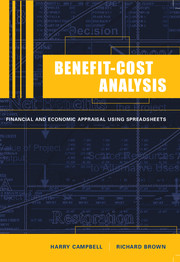Book contents
- Frontmatter
- Contents
- List of figures
- List of tables
- Preface
- Acknowledgements
- 1 Benefit-Cost Analysis: Introduction and Overview
- 2 Investment Appraisal: Principles
- 3 Investment Appraisal: Decision-Rules
- 4 Private Benefit-Cost Analysis: Financial Analysis
- 5 Efficiency Benefit-Cost Analysis
- 6 Calculating the Net Benefits to the Referent Group
- 7 Consumer and Producer Surplus in Benefit-Cost Analysis
- 8 Valuing Traded and Non-traded Commodities in Benefit-Cost Analysis
- 9 Incorporating Risk in Benefit-Cost Analysis
- 10 The Social Discount Rate, Cost of Public Funds, and the Value of Information
- 11 Weighting Net Benefits to Account for Income Distribution
- 12 Valuation of Non-marketed Goods
- 13 Economic Impact Analysis
- 14 Writing the Benefit-Cost Analysis Report
- Appendix 1 Case Study Assignment
- Appendix 2 Discount and Annuity Tables
- Index
12 - Valuation of Non-marketed Goods
Published online by Cambridge University Press: 05 September 2012
- Frontmatter
- Contents
- List of figures
- List of tables
- Preface
- Acknowledgements
- 1 Benefit-Cost Analysis: Introduction and Overview
- 2 Investment Appraisal: Principles
- 3 Investment Appraisal: Decision-Rules
- 4 Private Benefit-Cost Analysis: Financial Analysis
- 5 Efficiency Benefit-Cost Analysis
- 6 Calculating the Net Benefits to the Referent Group
- 7 Consumer and Producer Surplus in Benefit-Cost Analysis
- 8 Valuing Traded and Non-traded Commodities in Benefit-Cost Analysis
- 9 Incorporating Risk in Benefit-Cost Analysis
- 10 The Social Discount Rate, Cost of Public Funds, and the Value of Information
- 11 Weighting Net Benefits to Account for Income Distribution
- 12 Valuation of Non-marketed Goods
- 13 Economic Impact Analysis
- 14 Writing the Benefit-Cost Analysis Report
- Appendix 1 Case Study Assignment
- Appendix 2 Discount and Annuity Tables
- Index
Summary
Introduction
This Chapter deals with the methods and techniques used by economists to place monetary values on non-marketed goods and services, or, more specifically, those project inputs or outputs which affect the level of economic (material) welfare but which do not have market prices. While the discussion will focus mainly on environmental goods in order to illustrate the issues involved, the Chapter concludes with a brief discussion of various methods of valuing human life.
In previous Chapters we discussed how benefit-cost analysis involves the identification and valuation of a project's costs and benefits. Our analysis has so far been confined to those inputs and outputs that are exchanged through markets and where, in consequence, market prices exist. We recognized in Chapter 5 that the market does not always provide the appropriate measure of value and that shadow-prices sometimes have to be generated in order to better reflect project benefits or opportunity costs. This discussion was essentially about adjusting existing market prices where these were believed to be distorted, due perhaps to government intervention or to imperfections in the structure and functioning of markets. The present Chapter deals with another type of market failure – where there is no market for the input or output in question, and, therefore, no market price at which to value the cost or benefit.
As a starting point it is reasonable to ask why there is no private market for the commodity in question. Markets exist in order to trade ownership of goods and services – hamburgers and machine tools, haircuts and labour services. For economic agents to exchange ownership of a good or service there must exist a reasonably well-defined set of property rights that specify what is being traded.
- Type
- Chapter
- Information
- Benefit-Cost AnalysisFinancial and Economic Appraisal using Spreadsheets, pp. 261 - 287Publisher: Cambridge University PressPrint publication year: 2003



